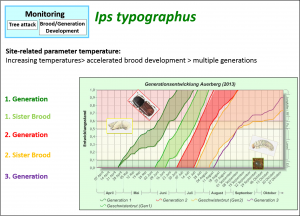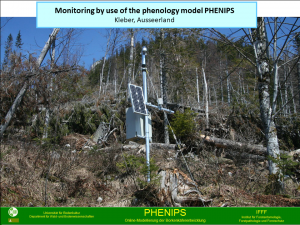Monitoring of bark beetle development by PHENIPS
PHENIPS as important element of bark beetle risk assessment
Monitoring of I. typographus flight times, tree attack and brood/generation development is a key element of bark beetle risk assessment (Fig. 1).
The phenology model (Baier et al., 2007)
PHENIPS is a phenology model based on air temperature and solar radiation recorded at the study site (Fig. 2) to simulate spatial and temporal variations in the seasonal development of I. typographus considering the microclimatic conditions in the phloem of Norway spruce. To model swarming activities, host tree infestation, rates of brood development, the incidence of sister broods and filial generations, and development status for successful hibernation at the end of the season, PHENIPS uses thresholds of photoperiod and air temperature as well as effective thermal sums of phloem temperature.
The onset of host tree infestation in spring is estimated using a lower threshold of 16.5 8C for flight activity and a mean thermal sum of 140 degree-days (dd) from beginning of April 1st onward.
A nonlinear function describes the rate of brood development, whereby effective thermal sums are calculated from accumulated degree-days of hourly temperature data using upper and lower temperature thresholds of 38.9°C and 8.3°C respectively.
At the time when 50% of the thermal sum for total development (557 dd) is reached, the model simulates re-emergence of parental beetles for the establishment of sister broods. Filial beetles leave the trees after maturation in order to search for new hosts.
Initiation of diapause: The model includes the discontinuance of the beetle’s reproductive activity at a day length <14.5 h. The rate of successful hibernation of established broods is predicted by assessing the developmental stage of initiated generations at the beginning of the cold period.
Model evaluation
PHENIPS was developed at Kalkalpen National Park (Upper Austria), where the beetles’ phenology was additionally monitored along with air and bark temperature measurements. For model validation, the timing of phenological events in the field was compared with predicted events using both, hourly recorded data at trap trees in the terrain and generated daily topo-climatic data. Using topo-climatic data, the onset of infestation was predicted with a mean absolute error of 1.3 days. The observed onset of emergence of filial beetles in the field was estimated with a mean error of 39 dd (Baier et al., 2007).
PHENIPS was additionally validated by a Czech research group (Berec et al., 2013) and has been included in various risk assessment frameworks (Seidl et al., 2007; Hlasny et al., 2011; Temperli et al., 2013; Pasztor et al., 2013; Mezei et al., 2017).
Online monitoring of bark beetle development
PHENIPS explicitly considers the strong effects of regional topography as well as stand conditions on local air and bark temperature and is suited for precise monitoring of the actual state of bark beetle development at the specific stand/tree level. Using topo-climatic data, PHENIPS simulates the maximum number of generations, which is necessary to assess the potential impact of bark beetle outbreaks at regional scale. As demonstrated by fig. 3, PHENIPS allows for a real-time simulation of I. typographus development for a specific site, graphically illustrated by the onset of swarming at a specific day of year and minima/maxima of generation/sister brood development.
References
Baier P., Pennerstorfer J. and Schopf A., 2007. PHENIPS—A comprehensive phenology model of Ips typographus (L.) (Col., Scolytinae) as a tool for hazard rating of bark beetle infestation. Forest Ecology and Management, 249(3): 171-186.
Berec L., Doležal P. and Hais M., 2013. Population dynamics of Ips typographus in the Bohemian Forest (Czech Republic): Validation of the phenology model PHENIPS and impacts of climate change. Forest Ecology and Management, 292: 1-9.
Hlásny T., Zajíčková L., Turčáni M., Holuša J. and Sitková Z., 2011. Geographical variability of spruce bark beetle development under climate change in the Czech Republic. Journal of Forest Science, 57: 242-249.
Mezei P., Jakuš R., Pennerstorfer J., Havašová M., Škvarenina J., Ferenčík J., Slivinský J., Bičárová S., Bilčík D., Blaženec M., Netherer S., 2017. Storms, temperature maxima and the Eurasian spruce bark beetle Ips typographus—An infernal trio in Norway spruce forests of the Central European High Tatra Mountains. Agricultural and Forest Meteorology 242: 85–95.
Pasztor F., Matulla C., Rammer W., Lexer MJ., 2014. Drivers of the bark beetle disturbance regime in Alpine forests in Austria. Forest Ecology and Management 318: 349–358.
Seidl R., Baier P., Rammer W., Schopf A. and Lexer MJ., 2007. Modelling tree mortality by bark beetle infestation in Norway spruce forests. Ecological Modelling, 206(3–4): 383-399.
Temperli C., Bugmann H. and Elkin C., 2013. Cross-scale interactions among bark beetles, climate change, and wind disturbances: a landscape modeling approach. Ecological Monographs, 83(3): 383-402.



